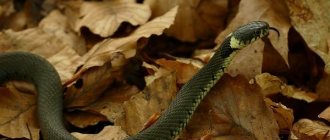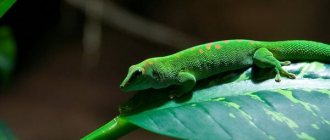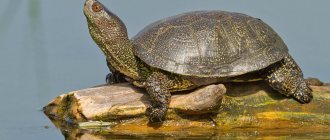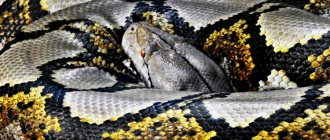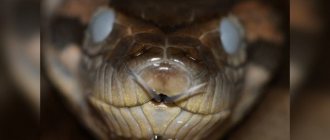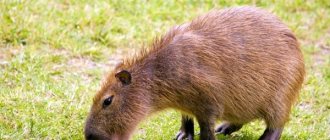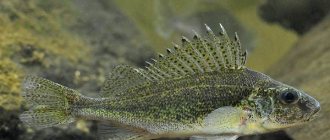- Wild animals
- >>
- Reptiles
The Gangetic gharial remains the only modern representative of its genus; the rest are now represented only in the form of fossils. This species itself is also on the brink: there are very few gharials left. They live in deep and fast rivers, feed on fish and spend almost all their time in water - more than any other crocodiles.
Description
So, the Gavial family of the order crocodiles is represented by only one species - Gangetic gharial . Growing quite large, at birth it is almost no different from ordinary other varieties.
But there is also a main feature, quite pronounced - a narrow muzzle and long jaws. With age, this adaptation to fish nutrition becomes more and more noticeable, the proportions get worse. The elongated mouth reaches from 65 to 105 cm.
The gharial's mouth is equipped with a row of teeth located slightly inclined and to the side. They are very sharp and elongated in shape, from 24 to 26 in the lower jaw, and more than 27 in the upper jaw. Visible even with the mouth closed. All this helps the reptile hunt and eat what it catches.
The cheekbone is not flat, as is observed in other crocodiles. The front part of the muzzle is expanded and has some soft appendage - another sign by which the gharial in the photo .
This is a resonator of the sound that occurs when exhaling. The growth reminded the local population of an Indian ghara pot. This is how the name of the genus gharial came from the word “ghVerdana”. This formation is present on the muzzles of males. It has a cavity to hold air, which is why males stay under water longer than females.
There are also the following signs:
The body length of the male is up to 6.6 m, the female is 2 times smaller. The weight of a male is up to 200 kg. The color of the back is coffee-colored, with green and brown tints, brown spots and stripes in youth. As you grow older, this whole range brightens. The belly is slightly yellow, fading to white or cream in color.
Poor development of the legs, making it difficult to move on land. Only by crawling on the ground does the reptile develop a significant speed of movement in the aquatic environment. The head is usually compared to a crocodile - pseudogharial. In adulthood, its outline lengthens and becomes thinner.
Small eye sockets. The eye is protected by a nictitating membrane for staying in water. The scutes start at the back of the head and go to the tail, forming a kind of shell of 4 rows of bone plates equipped with ridges. The tail has 19 scutes and the same number of scales with ridges.
Although the size of the animal is impressive, it does not attack humans; no such cases have been reported. The gharial crocodile ranks second in size after the combed crocodile (Crocodylus porosus).
Natural enemies of gharials
Photo: Gangetic gharial
There are no animals that specifically hunt adult gharials. In India they talk about their fights with tigers and bears, but if this happens, it is very rare, because usually these predators successfully find other prey instead of fighting each other and getting wounded.
The gharials themselves never attack large animals, which means that such battles are only possible on land, where they have practically no chance against much faster and stronger animals. Also in India they talk about the hostile attitude of elephants towards gharials - as if some of the elephants go berserk at the sight of them and try to trample them.
This is explained by the fact that crocodiles can catch small elephants, and the survivors remember this and take revenge after they become adults. How true these stories are is unknown. In any case, there is little threat to an adult gharial; cubs are another matter, because even small animals can cope with them.
They are hunted by:
- mongooses;
- monitor lizards;
- hyenas;
- baboons;
- marabou;
- storks.
Some of these look for clutches of gharials and, as soon as the female leaves, they destroy them and eat the eggs.
Interesting fact: The pupils of gharials open wider at night, thanks to which they see well in the dark, and the location of their eyes allows them to perfectly determine distance, which is very helpful in hunting.
Origin
The Gharial family is the oldest of the crocodiles. Its origin is associated with the period that occurred on the planet about 65 million years ago - the Cenozoic. The concept of gharial species is not used now, because only one of them has survived to this day. Although excavations reveal 12 fossilized species. Finds are found not only in India, but also in Africa, Europe, and South America.
The names Gangetic and Indian gharial are synonymous. Another name is the long-nosed crocodile. It is now the only species of the genus and family Gavialidae. However, according to encyclopedic information, it also includes the gharial crocodile, which is considered the closest relative.
Relationships with a person
Previously, the gharial crocodile was considered absolutely safe for people, since it was very difficult to eat large prey due to its narrow snout.
However, some pseudogharials cope with large animals, so they pose a potential danger to humans.
The first recorded attack on a person occurred in 2008, and two more attacks occurred in 2012.
This is due to the fact that recently the animal’s usual habitats have been increasingly destroyed, which affects changes in its behavior.
Habitat
The gharial is an animal (Gavialis gangeticus, lat.) that does not hunt outside the aquatic environment, but often comes ashore to bask in the sun or during the breeding season. In water, its movements can be called graceful, and also have significant speed, almost a record for crocodiles. The tail and membranes on the hind legs help to swim. Where can you find such individuals? Fast and deep rivers are a favorite environment.
The gharial lives in calm areas with high banks and chooses clean water. Deep lakes in the floodplain with sandy boundaries also suit him. There he forms nests and carries out basking - heating the reptile's body with the sun's rays.
Adults are characterized by homing (from the English home - house). That is, the reptile’s habit of returning to the nest, to the previous habitat, which is quite pronounced. — In the aquatic environment, these reptiles look for areas with a large number of fish.
The areas of individual males extend along the coast up to 20 km. Female territories reach 12 km in length. The crocodile in question spends most of its time in water and its calm areas. On land it only crawls and glides on its belly. But the development of moderate speeds is also possible.
Where does the gharial live?
Photo: Crocodile gharial
Previously, the range of these reptiles was quite wide, but has greatly decreased over the past century. Now they live only in the northern part of Hindustan. Most of them are in India, much less in Nepal and Pakistan. In these states, measures are being taken to protect them, so that they live mainly in nature reserves.
In Bangladesh, Bhutan and Myanmar they were found in the past but may have disappeared altogether, although they may still be found in remote areas where largely unexplored wildlife still persists and previously unknown populations of other rare animals are discovered from time to time.
In addition to the Ganges, gharials are found in the basins of rivers such as the Brahmaputra, Indus, Mahanadi, Meghna and some others. The natural conditions of the Indo-Ghana Plain are best suited for their habitat, as it abounds in the deep rivers that they love so much.
They need clean water where a lot of fish live - this could be a lake. Each male occupies a considerable area: approximately 20 square kilometers, while a female needs half as much. This territory should have banks that are convenient for climbing out on and warming up.
Interesting fact: Gharials can migrate tens of kilometers, but invariably return to the same favorite place. They can leave it only if conditions have changed: the amount of prey has decreased or the water has become dirty. Even in these cases, they do not leave immediately; they try to adapt to new conditions for some time.
Now you know where the gharial is found. Let's see what this crocodile eats.
Spreading
The gharial is mainly distributed in India. The area is the north of Hindustan, outlined by the system of basins of the Indus, Ganges, and Brahmaputra rivers. In Pakistan, Bangladesh and Nepal, it is now almost never found as it has become extinct in the region.
In the south, the natural habitat reaches the Mahanadi basin (India, Orissa state). Gharial was also found in a tributary of the Brahmaputra, the Manas River on the Bhutan-Indian border. But now it is almost impossible to confirm. The same can be said about the Kaladan River in western Burma. Although at the beginning of the 20th century. similar crocodiles were present there.
Character, behavior, lifestyle
Gharials are considered good parents. Females are especially characterized by this quality. At the beginning of the mating season, they create nests. Then they look after the offspring until the period of independence begins.
Such crocodiles are not aggressive. But the fight for females and the division of territories are exceptions to this rule. Fish-eating reptiles live in families, in which there is one male and several females. Indian culture recognizes them as sacred animals.
Continuation of the family line
Gharial crocodiles build their nests on land, in the shade of trees. The animal builds a small hill, about 60 cm high, from sand, branches, leaves, and peat.
The female lays very large eggs - about 9 cm in length and 6 cm in width, with a mass twice as large as that of representatives of other species. The female begins to build a nest within a month after mating, and 1-2 weeks after the start of nesting she lays about 60 eggs, after which she covers them with a large amount of vegetation.
After 90-100 days, cubs are born, the body length of which is only about 10 cm. Both eggs and hatched babies become easy prey for wild pigs, large reptiles and other animals.
This happens because female gharial crocodiles do not care for their offspring and do not guard their nests. Both females and males reach sexual maturity by the age of 20.
What to eat, diet
The gharial hunts for fish, which is its most preferred food. But older individuals also eat birds and small animals approaching the river. Food also consists of insects, frogs, snakes.
Eating of carrion, including human remains, is also observed. After all, they are traditionally buried in the Ganges, the sacred river. Due to this fact, the belly of the animal sometimes contains jewelry. This reptile also sometimes swallows small stones; they stimulate its digestion.
When hunting for fish, for example, striped catfish, the crocodile grabs it with a lateral movement of its head, moving it from side to side. The teeth hold the prey, preventing it from slipping out and escaping. This species is not dangerous for people, although it is large in size.
Reproduction
During the first decade of life, the young gharial turns into a sexually mature individual. The process of emergence of young animals occurs in the following stages. The laying of eggs is preceded by the mating season. Crocodiles become active for breeding purposes from November to January.
Males complete a “harem” by choosing several females, and therefore battles sometimes occur between them. And the size and strength of a crocodile determines the number of females it has. The period from fertilization to egg laying lasts from 3 to 4 months.
Nesting occurs during the dry season - March and April, when the sandy coast opens. At night, females dig a hole for themselves to lay eggs in the sand at a distance of 3 or 5 meters from the water. - Up to 90 oval eggs are laid in the prepared place (usually 16 - 60).
Their dimensions are approximately 65 by 85 mm or a little more, their weight exceeds other types of crocodiles and is 160 grams. The nest is camouflaged with plant material. — After 2.5 months, the baby gharials come out into the world. The mother does not move them into the aquatic environment, teaching them survival and caring for them.
Seasonal conditions and the size of the crocodile determine the size of the clutch, buried in the sand of the shallows, covered with vegetation. Incubation takes 90 days (on average), but can also be from 76 to 105 days.
The female guards the nest site, the crocodiles themselves and helps them hatch. Every night she comes to the eggs. Each male has relationships with several females, to which other crocodiles are not allowed.
Lifespan
Sexual maturity of females occurs at the age of 10 years with a size of 3 meters. But according to statistics, in nature only 1 gharial out of 40 reaches it. It is estimated that 98% of gharials do not live to be 3 years old. Therefore, the population average represents a dismal result.
Reliable data has been recorded about one of the females living at the London Zoo. This is 29 years old. It is believed that late maturation and significant size predetermine long life expectancy. In nature, it is marked by a period of 20 or 30 years. The official figure of 28 years is unattainable due to the activities of poachers, pollution of water bodies, and drainage.
Notes
- Ananyeva N. B., Borkin L. Ya., Darevsky I. S., Orlov N. L.
Five-language dictionary of animal names. Amphibians and reptiles. Latin, Russian, English, German, French. / under the general editorship of academician. V. E. Sokolova. - M.: Rus. lang., 1988. - P. 139. - 10,500 copies. — ISBN 5-200-00232-X. - Willis, R. E.;
McAliley, L.R.; Neeley, E.D.; Densmore, L. D. Evidence for placing the false gharial (
Tomistoma schlegelii
) into the family Gavialidae: Inferences from nuclear gene sequences // Molecular Phylogenetics and Evolution. - 2007. - Vol. 43. - P. 787–794. — DOI:10.1016/j.ympev.2007.02.005. - [www.academia.edu/4075899/Selvaraj_2013_Tomistoma Selvaraj 2013 Tomistoma]. www.academia.edu. Retrieved December 28, 2015.
- Bezuijen, M. R., Shwedick, B. M., Sommerlad, R., Stevenson, C., & Stuebing, R. B. (2010). Tomistoma Tomistoma schlegelii
. Crocodile: Status Survey and Conservation Action Plan. Darwin: Crocodile Specialist Group, 133-138. - Piras, P., Colangelo, P., Adams, D. C., Buscalioni, A., Cubo, J., Kotsakis, T., & Raia, P. (2010). The Gavialis–Tomistoma debate: the contribution of skull ontogenetic allometry and growth trajectories to the study of crocodylian relationships
. Evolution & development, 12(6), 568-579. - Rachmawan, D., Brend, S. (2009). [www.iucncsg.org/365_docs/attachments/protarea/CSG%20-e8b500ff.pdf Human-Tomistoma interactions in central Kalimantan, Indonesian Borneo]
Crocodile Specialist Group Newsletter January 2009 - March 2009. Volume 28 No. 1:9-11. - Sideleau, B., & Britton, A. R. C. (2012). A preliminary analysis of worldwide crocodilian attacks
. In Crocodiles Proceedings of the 21st Working Meeting of the IUCN-SSC Crocodile Specialist Group. Gland, Switzerland: IUCN (pp. 111–114).
Population protection
The change in the natural habitat area occurred as a result of fishing for this animal. There are also the following reasons. There are frequent cases of death when caught in fishing nets. Declining fish stocks. Reducing habitable areas. - Collecting eggs to treat a number of diseases, hunting for growths on the nose, which are an aphrodisiac that increases male potency.
The supply of necessary food decreases over time, which leads to a decrease in numbers. In addition to natural factors, poachers are a concern. Now the situation is in a critical state, as many populations are oppressed.
But in India they still exist, as they are maintained by artificial incubation of eggs on crocodile farms. Young animals are produced, which are then released into a favorable habitat. The conservation of the gharial is carried out according to the Government of India project of 1975, which has been in force since 1977.
The program to transfer one-year-old crocodiles into the wild did not lead to a significant improvement in their fate. Thus, out of 5,000 released cubs, only individuals living in 3 places located in national reserves successfully reproduced.
In 1978, similar measures were taken in Nepal National Park. Here, at the confluence of two rivers (Rapti and Rue), giant individuals are protected. The events have an optimistic outlook. However, this very rare representative of crocodiles is listed in the Red Book. The reason is that it is endangered.
The reptile can be saved by cleaning Indian rivers from poisons and sewage waste. But today the habitat is characterized by severe pollution. The living condition - clean fresh river water is not met as a mandatory environmental requirement. This indicates that the species is doomed to extinction. The ancient crocodile is classified as an almost extinct and very vulnerable member of the fauna.
Links
- The Reptile Database: [reptile-database.reptarium.cz/species.php?genus=Tomistoma&exact%5B%5D=genus&species=schlegelii Tomistoma schlegelii
] (English) - [crocodilian.com/cnhc/csp_tsch.htm crocodilian.com: Tomistoma schlegelii
] (English)
| International Red Book : Incorrect or missing image Endangered Species IUCN 2.3 |
| : Incorrect or missing image | To improve this biology article, it is advisable to:
|
